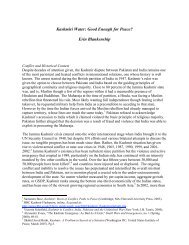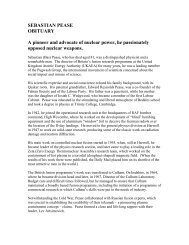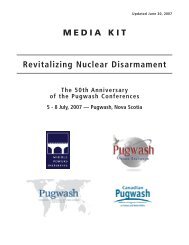Eliminating Stockpiles of Highly Enriched Uranium - Pugwash ...
Eliminating Stockpiles of Highly Enriched Uranium - Pugwash ...
Eliminating Stockpiles of Highly Enriched Uranium - Pugwash ...
You also want an ePaper? Increase the reach of your titles
YUMPU automatically turns print PDFs into web optimized ePapers that Google loves.
Chapter 5: Technical aspects <strong>of</strong> HEU elimination<br />
The inherent proliferation risks <strong>of</strong> unirradiated HEU can be reduced in a number <strong>of</strong><br />
ways. One approach could simply be to establish centralised and highly protected<br />
storage facilities for all the materials. This option, however, will be costly and only be<br />
effective for short-term or immediate purposes. It does not reduce the stocks, and<br />
therefore the long-term threats associated with HEU.<br />
All facilities containing HEU continuously need upgrades, overhauls and welltrained<br />
guards. With the rapid societal transformations, there is no guarantee that it<br />
will be easy or even possible to maintain the needed security effectiveness <strong>of</strong> the<br />
nuclear weapons-usable materials. 68 While adequate physical protection systems are a<br />
minimum requirement for avoiding HEU falling into the hands <strong>of</strong> unauthorized users,<br />
physical protection as such is not a viable and final solution to the proliferation risks.<br />
A second potential approach could be to grind and dissolve HEU in the oceans<br />
and thus ”give the materials back to nature”. Though HEU dumping would represent<br />
minuscule releases <strong>of</strong> radioactivity and no harm to health and environment, such<br />
efforts would clearly represent an up-hill political battle. Most likely, it would be very<br />
hard to convince the public opinion that any released amount would be minuscule<br />
compared to the existing 3 billion metric tons <strong>of</strong> uranium-235 in the oceans.<br />
Moreover, new security risks may emerge. The transportation logistics <strong>of</strong> land and sea<br />
transports could create situations where the HEU is vulnerable and prone to theft,<br />
sabotage and accidents. Proper accountability in conjunction with the discharges may<br />
also be a challenge.<br />
A third approach is defined (and described in chapter 4) by the ongoing US-<br />
Russian HEU deal whereby the military HEU is down-blended, commercialised, and<br />
burned in civilian nuclear power reactors. This solution has merits, as the electricity<br />
(and thus the financial) potential <strong>of</strong> the HEU is utilized. However, given the diverging<br />
political views on nuclear power within Europe, a full-fledged commercialisation <strong>of</strong><br />
the issue may be neither feasible nor desirable. 69 Strong commercial considerations<br />
may thus impede a swift and focused elimination process.<br />
68 In a recent study about the establishment <strong>of</strong> physical protection in the NIS, it was concluded that<br />
many <strong>of</strong> the best-trained and most efficient persons are not interested in working to secure nuclear<br />
power plants etc. It is much more attractive to work for ”tangible companies” that pay good salaries<br />
like banks etc. (see George Bunn, Fritz Steinhäusler, Lyudmila Zaitseva, ”Strengthening Nuclear<br />
Security Against Terrorists and Thieves Through Better Training”, The Nonproliferation Review, Fall-<br />
Winter, 2001) In this context, the nuclear sector can stand out as archaic and less interesting as a work<br />
place in a post-deterrence era. This development may become stronger in the coming decades.<br />
69 In Europe, attitudes regarding the present and future role <strong>of</strong> civilian nuclear power are diverse. Some<br />
states, e.g. France, the UK, Belgium, and Finland rely heavily on nuclear power, and intend to do so for<br />
the foreseeable future. Others, like Sweden and Germany, have put forward long-term policy options<br />
by which national nuclear energy sectors may be abolished. Under these circumstances, a common EU<br />
position towards uranium fuel originating from Russian HEU stocks may be hard to conceive –<br />
particularly if it is seen as an expansion <strong>of</strong> civilian nuclear energy in Europe. Euratom also limits in a<br />
certain way Russian quota on selling HEU reprocessed into LEU. Regulations <strong>of</strong> Euratom require as a<br />
a diversification <strong>of</strong> sources <strong>of</strong> supply: Every user (nuclear power plant) must have not less than four<br />
alternative sources <strong>of</strong> fuel supply.<br />
24







